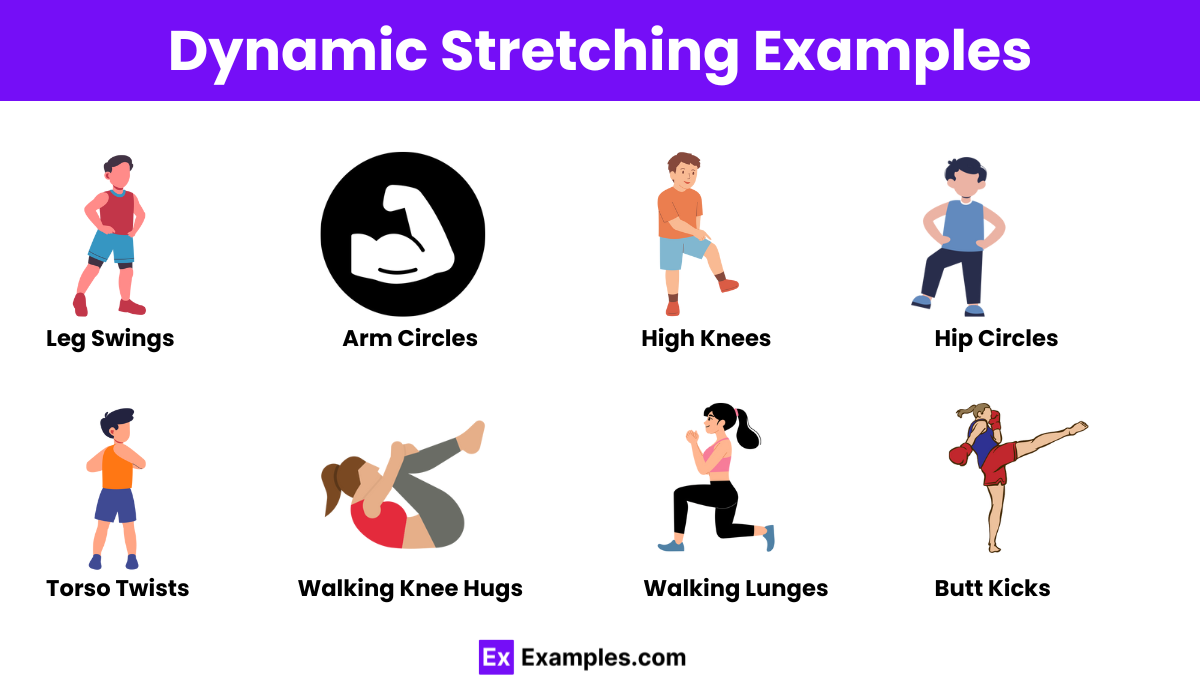What is the primary purpose of dynamic stretching?
To increase flexibility
To prepare muscles for activity
To improve balance
To enhance muscle strength


Dynamic stretching involves performing controlled movements that prepare the muscles, ligaments, and other soft tissues for exercise and safety. Unlike static stretching, dynamic stretches mimic the activity or sport you’re about to perform, making them ideal for pre-exercise warm-ups. This type of stretching enhances flexibility, increases blood flow, and improves range of motion. Dynamic stretching routines often include leg swings, arm circles, and walking lunges, promoting better overall athletic performance and reducing injury risks.
Dynamic stretching involves controlled, active movements that prepare muscles and joints for exercise. Unlike static stretching, it mimics the activity or sport to be performed, enhancing flexibility, increasing blood flow, and improving range of motion, thus reducing the risk of injury.

| Aspect | Dynamic Stretching | Static Stretching |
|---|---|---|
| Definition | Active movements stretching muscles | Holding a stretch in one position |
| Purpose | Warm up muscles, improve performance | Cool down, improve flexibility |
| When to Perform | Before exercise or physical activity | After exercise or as part of a flexibility routine |
| Movement | Involves continuous motion | Involves holding a position |
| Duration | Short bursts (e.g., 10-15 seconds each) | Longer holds (e.g., 15-60 seconds each) |
| Benefits | Increases blood flow, enhances coordination | Increases flexibility, reduces muscle tension |
| Examples | Leg swings, arm circles, high knees | Hamstring stretch, calf stretch, quad stretch |
| Injury Prevention | Reduces risk of injury during activity | Helps in muscle recovery post-activity |
Do dynamic stretching before exercise as part of a warm-up routine.
Dynamic stretching improves flexibility, increases blood flow, and prepares muscles for physical activity.
Dynamic stretching involves movement, while static stretching involves holding a position for a period of time.
Yes, dynamic stretching can enhance performance by increasing range of motion and muscle temperature.
Yes, dynamic stretching can be adapted for all age groups and fitness levels.
A dynamic stretching session typically lasts 5-10 minutes.
Examples include leg swings, arm circles, and walking lunges.
Yes, dynamic stretching can help reduce the risk of injuries by preparing muscles for activity.
Yes, dynamic stretching is beneficial for various types of workouts, including cardio, strength training, and sports.
Yes, you can perform dynamic stretching daily as part of your warm-up routine.
Text prompt
Add Tone
10 Examples of Public speaking
20 Examples of Gas lighting
What is the primary purpose of dynamic stretching?
To increase flexibility
To prepare muscles for activity
To improve balance
To enhance muscle strength
Which of the following is an example of a dynamic stretch?
Static hamstring stretch
Standing quadriceps stretch
Leg swings
Seated toe touch
How does dynamic stretching differ from static stretching?
Dynamic stretching involves movement; static stretching does not
Dynamic stretching is done for a longer duration
Static stretching is more beneficial for warm-ups
Dynamic stretching requires no movement
When is the best time to perform dynamic stretching?
After exercise
Before a workout
During a workout
Anytime throughout the day
Which of the following benefits is associated with dynamic stretching?
Decreased heart rate
Improved muscle elasticity
Increased muscle soreness
Reduced coordination
What type of movements are commonly used in dynamic stretching?
Quick, jerky motions
Slow, controlled stretches
Continuous movements through a range of motion
Isometric holds
Which of the following activities is NOT typically included in a dynamic stretching routine?
Arm circles
High knees
Butterfly stretch
Walking lunges
Why is dynamic stretching particularly useful for athletes?
It helps with relaxation
It improves coordination and balance
It enhances overall muscle strength
It allows for mental preparation
How long should a dynamic stretching session typically last?
5-10 minutes
15-20 minutes
30-45 minutes
1 hour
Which of the following is a recommended practice during dynamic stretching?
Holding stretches for long periods
Performing movements at high speeds
Ensuring movements are controlled and smooth
Stretching only major muscle groups
Before you leave, take our quick quiz to enhance your learning!

